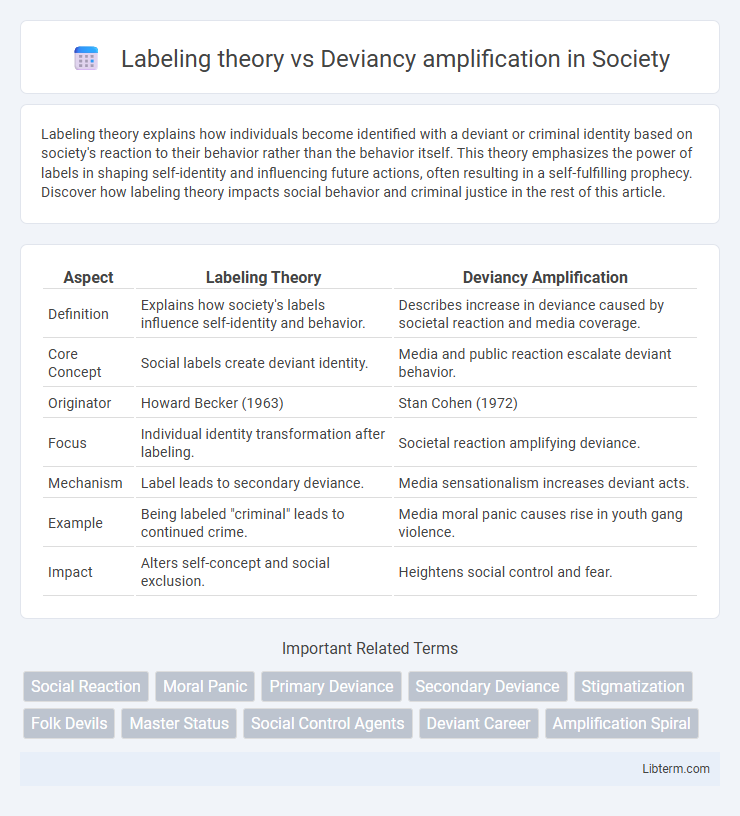Labeling theory explains how individuals become identified with a deviant or criminal identity based on society's reaction to their behavior rather than the behavior itself. This theory emphasizes the power of labels in shaping self-identity and influencing future actions, often resulting in a self-fulfilling prophecy. Discover how labeling theory impacts social behavior and criminal justice in the rest of this article.
Table of Comparison
| Aspect | Labeling Theory | Deviancy Amplification |
|---|---|---|
| Definition | Explains how society's labels influence self-identity and behavior. | Describes increase in deviance caused by societal reaction and media coverage. |
| Core Concept | Social labels create deviant identity. | Media and public reaction escalate deviant behavior. |
| Originator | Howard Becker (1963) | Stan Cohen (1972) |
| Focus | Individual identity transformation after labeling. | Societal reaction amplifying deviance. |
| Mechanism | Label leads to secondary deviance. | Media sensationalism increases deviant acts. |
| Example | Being labeled "criminal" leads to continued crime. | Media moral panic causes rise in youth gang violence. |
| Impact | Alters self-concept and social exclusion. | Heightens social control and fear. |
Introduction to Labeling Theory and Deviancy Amplification
Labeling theory explains how individuals become deviant when society labels their behavior as such, shaping their self-identity and social reactions. Deviancy amplification describes the process by which societal responses to deviance intensify and escalate the deviant behavior, often through increased media attention or law enforcement actions. Both concepts highlight the social construction of deviance and the feedback loop created by societal reactions that reinforce or magnify deviant actions.
Historical Background and Key Theorists
Labeling theory emerged in the 1960s through the work of sociologists like Howard Becker and Edwin Lemert, emphasizing how societal reaction and labels contribute to deviant behavior. Deviancy amplification, developed by Stanley Cohen in the early 1970s, explains how media and public reaction can intensify deviant behavior, creating moral panics. Together, these theories provide critical insight into the social construction of deviance and the powerful role of societal responses in shaping individual identities.
Core Concepts of Labeling Theory
Labeling theory centers on the idea that deviance is not inherent in an act but results from society's reaction and the labels assigned to individuals, emphasizing how stigmatization influences identity formation. Core concepts include primary deviance, which involves initial norm violations without self-identification as deviant, and secondary deviance, where labeled individuals embrace the deviant identity, intensifying their behavior. The theory highlights the role of societal power in defining deviance and its consequences, contrasting with deviancy amplification, which focuses on the escalation of deviant behavior through societal reaction and media portrayal.
Principles of Deviancy Amplification
Deviancy amplification describes the process how societal reaction to deviant behavior can increase and intensify that behavior, often through media sensationalism and law enforcement responses. Key principles of deviancy amplification include the initial deviant act, societal overreaction, and the resulting amplification leading to increased deviance and social control measures. This theory highlights how public labeling and moral panic can escalate deviance beyond its original scope, contrasting with labeling theory which focuses primarily on the impact of labels on individual identity.
Similarities Between Labeling Theory and Deviancy Amplification
Labeling theory and deviancy amplification both emphasize the social construction of deviance through societal reactions and the consequences of defining certain behaviors or individuals as deviant. Both theories highlight how negative labels can reinforce deviant identities, escalating the frequency and severity of deviant acts. The cyclical process of stigmatization and intensified deviance underlies the feedback loop central to both frameworks in understanding social control and behavior.
Differences in Theoretical Approaches
Labeling theory centers on the process by which individuals are identified and categorized as deviant, emphasizing the social reaction and its impact on self-identity and behavior. Deviancy amplification explores how media and societal responses intensify deviant behavior by increasing public concern and law enforcement actions. The core difference lies in labeling theory's focus on individual identity formation, whereas deviancy amplification highlights the broader social dynamics that exacerbate deviance through feedback loops.
Impact on Individuals and Society
Labeling theory emphasizes that individuals internalize deviant labels, which can alter their self-identity and perpetuate further deviant behavior, intensifying social stigma and exclusion. Deviancy amplification describes how societal reaction and media portrayal can escalate deviant behavior by increasing public fear and reinforcing negative stereotypes, resulting in social control measures that may exacerbate the problem. Both concepts highlight the cyclical impact of societal responses on individual behavior and broader social order, influencing crime rates and public policy development.
Role of Media and Social Institutions
Labeling theory emphasizes how media and social institutions contribute to deviance by assigning stigmatizing labels that reinforce negative self-identity and social exclusion, which perpetuates deviant behavior. Deviancy amplification highlights the media's role in exaggerating deviant acts, creating moral panics that lead to increased social control and further deviance through heightened public fear and institutional responses. Both theories illustrate the powerful influence of media narratives and social institutions in shaping societal reactions and reinforcing deviant identities.
Criticisms and Limitations of Both Theories
Labeling theory faces criticism for its potential to overemphasize societal reaction while neglecting the initial causes of deviant behavior. Deviancy amplification critiques highlight its tendency to assume media exaggeration universally escalates deviance, lacking empirical consistency in diverse contexts. Both theories exhibit limitations in addressing complex social factors and individual agency within deviant behavior dynamics.
Contemporary Relevance and Applications
Labeling theory remains significant in understanding how societal reactions contribute to the persistence of deviant behavior by highlighting the impact of stigmatization on individual identity and social interactions. Deviancy amplification explains the cyclical process where media and public response to deviance escalate the visibility and prevalence of deviant acts, often intensifying social control mechanisms. Both theories are applied in contemporary criminology, social policy, and media studies to address issues such as juvenile delinquency, criminal justice reform, and the influence of public discourse on marginalized groups.
Labeling theory Infographic

 libterm.com
libterm.com